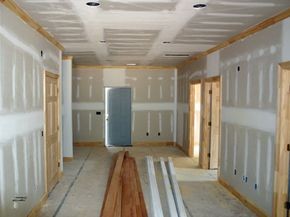Plaster is a building material used for coating walls and ceilings. To truly understand interior walls and construction, it’s crucial to understand “What Is Plaster”, how it’s made, and how it compares to drywall.
Composition and Creation of Plaster
Plaster typically comprises a binder, such as gypsum, lime, or cement, mixed with water and aggregates like sand. The mixture hardens to create a durable, smooth surface. There are different types of plaster, each with unique properties and applications:
- Gypsum Plaster: Made from gypsum, a naturally occurring mineral, gypsum plaster is commonly used for interior walls and ceilings.
- Lime Plaster: Created from limestone, lime plaster offers excellent breathability and is often used in older buildings.
- Cement Plaster: Using cement as the binder, cement plaster is stronger and more water-resistant, making it suitable for exterior applications.
Plaster Application Techniques
Applying plaster is a multi-stage process that requires skill and precision. The general steps include:
- Surface Preparation: The surface must be clean, dry, and free of loose materials. Applying a bonding agent may be necessary for smooth or non-porous surfaces.
- Mixing: The plaster mix should be prepared according to the manufacturer’s instructions, achieving a smooth, consistent consistency.
- Application: Plaster is applied in layers, with each layer allowed to dry before the next is applied. Traditional plastering often involves three coats: a scratch coat, a brown coat, and a finish coat.
- Finishing: The final coat is smoothed to create the desired texture. Various tools and techniques can achieve different finishes, from smooth to textured.
Advantages of Using Plaster
Plaster offers several advantages over other wall and ceiling materials:
- Durability: Plaster is highly durable and can last for many years with proper maintenance.
- Aesthetic Appeal: Plaster can create a smooth, seamless surface that enhances the appearance of a room. It also allows for unique textures and decorative finishes.
- Soundproofing: Plaster provides excellent sound insulation, reducing noise transmission between rooms.
- Fire Resistance: Plaster is naturally fire-resistant, offering added protection to buildings.
- Breathability: Lime plaster, in particular, allows moisture to pass through, which helps regulate indoor humidity and prevent moisture-related problems.
 Drywall is ready for painting, showcasing a smooth surface.
Drywall is ready for painting, showcasing a smooth surface.
Plaster vs. Drywall: A Comparison
While plaster offers numerous benefits, it also has some drawbacks compared to drywall. Here’s a comparison:
| Feature | Plaster | Drywall |
|---|---|---|
| Installation | More time-consuming and labor-intensive | Faster and easier to install |
| Cost | Generally more expensive | Less expensive |
| Durability | Highly durable and long-lasting | Less durable than plaster and prone to damage from impacts and moisture |
| Appearance | Smooth, seamless finish with potential textures | Can achieve a smooth finish, but joints are often visible |
| Soundproofing | Excellent sound insulation | Moderate sound insulation |
| Fire Resistance | Naturally fire-resistant | Fire-resistant properties due to the water in the boards |
| Moisture | Some types (like lime plaster) are breathable | Susceptible to water damage if exposed to moisture over long periods. Specialty boards are available with better water resistance. Paperless options help mitigate mold problems. |
Modern Innovations in Plaster
Modern plaster products incorporate advanced technologies to improve performance and ease of use. These innovations include:
- Pre-mixed plasters: These ready-to-use plasters eliminate the need for on-site mixing, saving time and labor.
- Lightweight plasters: Formulated with lightweight aggregates, these plasters reduce the load on structures and are easier to apply.
- Polymer-modified plasters: These plasters incorporate polymers to enhance flexibility, adhesion, and water resistance.
Conclusion
“What is Plaster?” It’s a versatile and durable material that has been used for centuries to create beautiful and functional walls and ceilings. While it requires more skill and time to apply than drywall, its numerous advantages, including durability, aesthetic appeal, and soundproofing, make it a worthwhile investment for many construction projects. Whether you’re renovating an old building or constructing a new one, understanding the properties and applications of plaster can help you make informed decisions and achieve exceptional results.